At DSS Europe 2024 in Munich, invidis presented its first "Green Signage - Hall of Fame". We featured 14 products and solutions that serve as great examples for more sustainable digital signage.
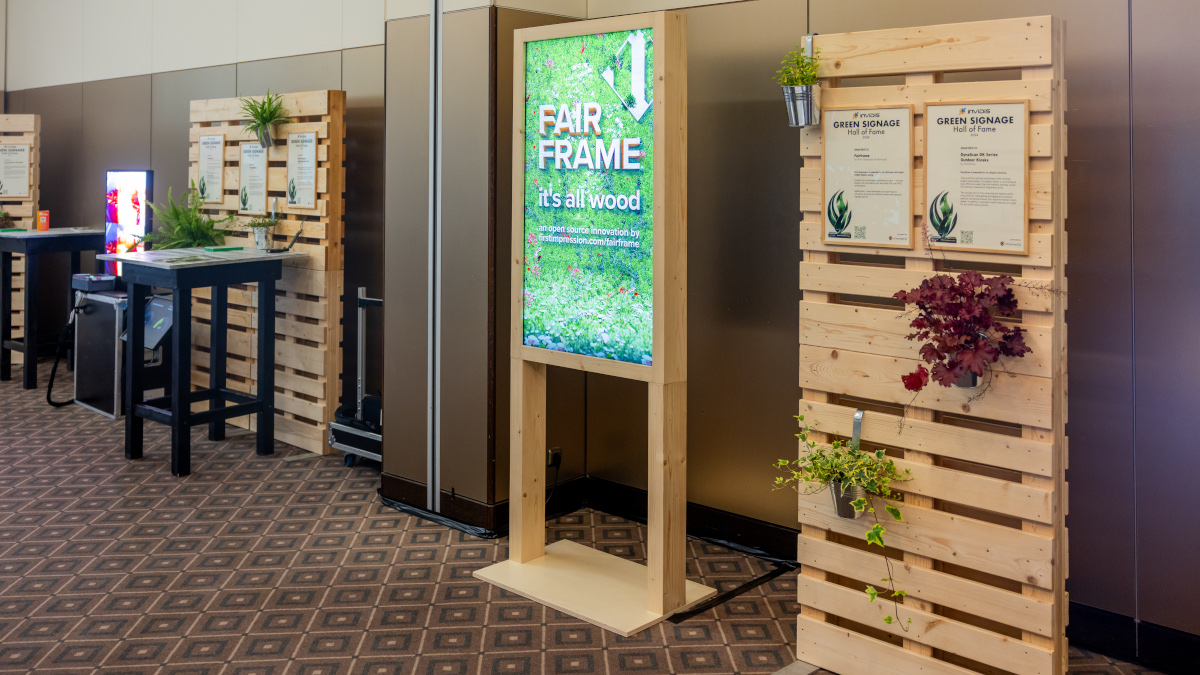
Green Signage: The invidis Hall of Fame 2024
When invidis established the term Green Signage several years ago, nobody really knew what to make of it. But the industry has now caught up. Especially within the past two years, we saw an upsurge of innovative technologies that aim at reducing energy consumption, at enabling a second life-span, or at using recyceld materials.
At DSS Europe 2024, we showcased some of our favorite examples. In this video, Daniel Oelker and Antonia Hamberger from invidis take you on a tour through our “Green Signage – Hall of Fame”:
The top 14 solutions chosen this year are:
Sharp/NEC for Remote Power Switch
Sharp/NEC’s “Led-RPS-CL-R” adds a remote power control while limiting the inrush current and eliminating standby power loss. Some characteristics:
- OW: Eliminates the standby power loss of any LED Wall
- Remote Power Switching: switchable by Room Management Systems thanks to easy integration via RS-485 or potential-free contacts
- Safe Operation: Inrush current limiting minimizes the impact on the facility electricity systems and lowers the amount of supply lines
Google for ChromeOS Flex
ChromeOS Flex is a secure, cloud-first, easy-to-manage, and fast operating system for PCs and Macs.
ChromeOS Flex is free to download and is a sustainable way to modernize PCs and Macs. By revitalizing older devices with this lightweight operating system, you extend their lifespan and significantly reduce electronic waste.
Additionally, ChromeOS Flex is designed for energy efficiency, using 19 percent less energy on average, leading to environmental benefits and lower operating costs.
Cingerine for its DS816 Digital Signage Player
Cingerine’s DS816 is a digital signage player that provides substantial energy saving capabilities. It‘s a standalone, fanless, 24/7 player
with ultra-low power consumption.
It is based on 12nm technology, featuring an AI accelerator, integrated storage, and gapless 2K + 4K image/video playout. On-device security is guaranteed by the Cingerine 4.0 Secure Digital Signage OS with RRR (Reactive Real-Time Rendering).
Control and monitoring is driven by the cloud-based Cingerine CMS.
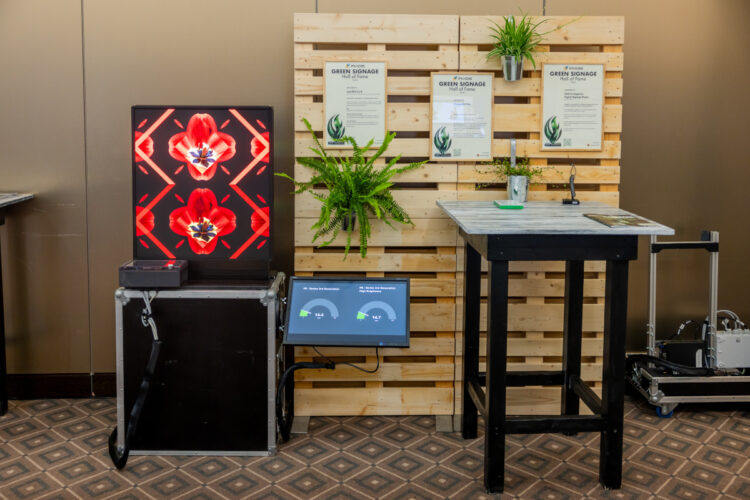
LED Studio for its Edge Series
The Edge Series by LED Studio offers the largest 16:9 single die-cast cabinets available in sizes of 43“, 55“, and 65“.
The cabinets were engineered to utilise up to 60 percent fewer internal electrical components, thus minimising dependence on raw materials.
The innovative V1 Architecture developed in-house enables a choice among three pixel technologies (SMD, Flip Chip, COB). This selection can be made either at the point of purchase or throughout the product’s lifespan.
Sony for its 700nit BZ40L Series
The BZ40L professional display series by Sony achieved EPREL rankings of E (65“, 75“) and F (55“, 85“). It boasts efficient power consumption, light sensing tech, while an easy-to-use ECO dashboard allows a centralized management of energy-saving settings.
The displays are manufactured with recycled materials, reducing virgin plastic usage by up to 60 percent. Optimized packaging decreases plasitic volumes by 35 percent and cuts CO2 emissions during transportation by 15 percent.
Ambient light sensing and signal power processing omptimize brightness and power usage ensuring an optimal viewing experience while conserving energy.
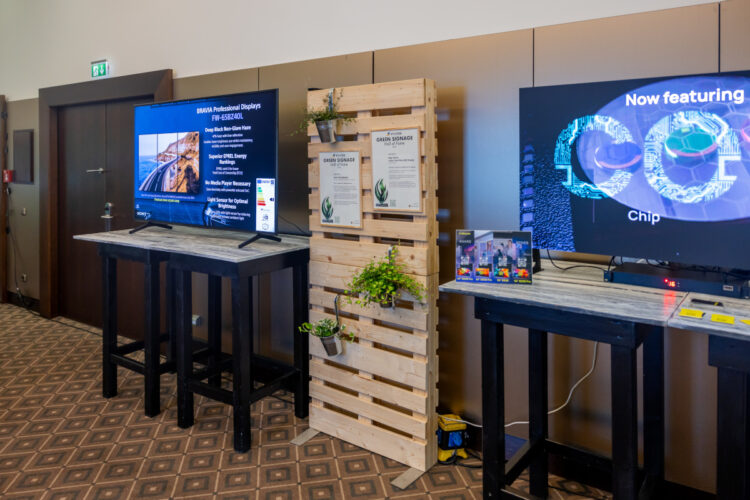
Samsung for its UHD Smart Signage QH55C
The Crystal UHD Smart Signage QH55C displays by Samsung achieved a reduction in 168 listed carbon footprints for 3 listed Stock Keeping Units (SKUs) and 3 Listed Products (B2C) sold Cradle-to-Grave.
They are sold in over 56 geographies in accordance with:
- PAS 2050:201: Specification for the assessment of the life cycle greenhouse gas emissions of goods and services
- Product Carbon Footprints: Requirements for Certification v2
Broadsign for Complying with Sustainable Software Engineering
Broadsign is the first major Out-of-Home software platform to formalize its commitment to achieving carbon neutrality. By following the principles of sustainable software engineering, Broadsign works on developing designed to enhance the accountability and sustainability initiatives of both employees and customers within the OoH ecosystem.
Broadsign shows that large sustainability improvements can be made in other sectors than hardware.
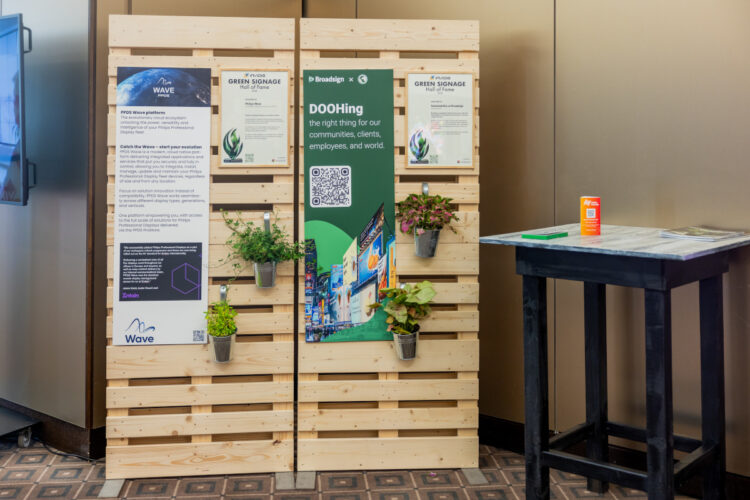
Dynascan for its DK Series Outdoor Kiosks
Outdoor display manufacturer Dynascan prioritizes optimal performance with minimal power consumption. Its outdoor kiosks consume at least 25 percent less power than the industry average, as determined by comparative brightness levels.
The savings derive from selecting the highest-performance LEDs for backlighting and applying innovative passive cooling techniques that require minimal to zero power. In addition, recyclable metal materials are used during construction.
First Impression Audiovisual for its Fairframe
First Impression’s Fairframe is an ultra-light-weight display casing. Crafted from sustainable Scandinavian wood, it not only features full recyclability but also holds FSC and PEFC certifications.
Additionally, the product was developed as an open-source innovation, pushing the industry forward with greener signage options.
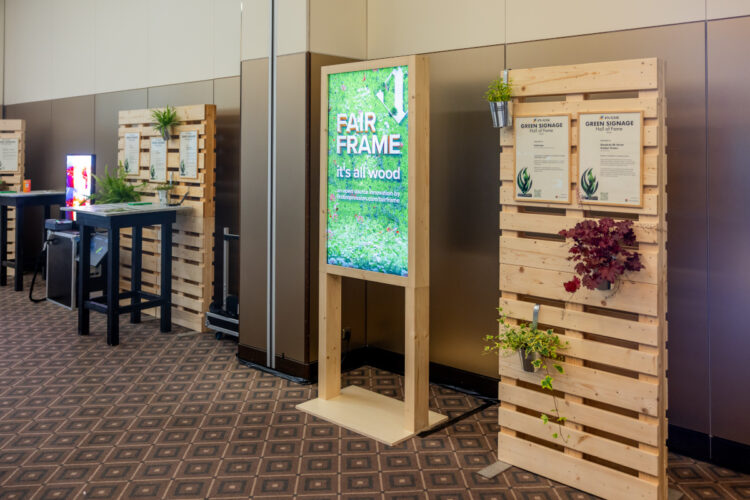
SignageOS for Cloud Control
SignageOS’ Cloud Control is a device management platform tailored to digital signage. Users can optimize display performance by automating power states based on predefined schedules. This allows to conserve energy and manage uptime effectively by setting on/off times for non-business hours or low-foot traffic periods.
Additionally, Cloud Control offers brightness scheduling to control the displays’ brightness settings remotely. The platform‘s scheduling flexibility allows for seamless alignment with operational schedules across different branches, fostering energy savings and cost reduction without necessitating physical intervention.
Cloud Control is compatible with more than 50 hardware platforms.
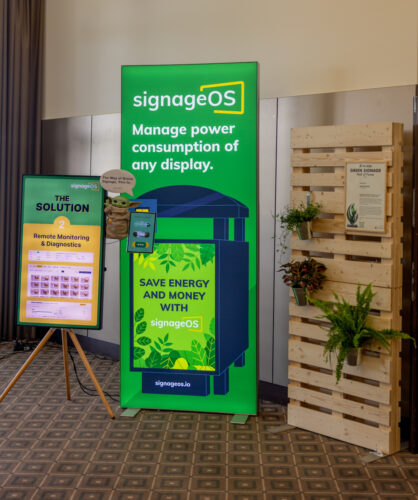
PPDS for Philips Wave
The cloud platform Wave enables remote device management and distribution of premium solution partner applications for a professional display fleet. The platform’s core advantages include ease-of-use, ease-of-integration with its API-first architecture,
reliability and global scalability.
In addition, using Wave reduces the need for costly truck rolls and additional hardware with Philips smart SoC displays.
Absen for its KLCOB Micro LED Series
The KLCOB product range by LED manufacturer Absen combines high brightness with efficient heat dissipation. By using common cathode technology, Absen has also managed to reduce energy consumption significantly, thus created a more sustainable product line.

Visionect for its Place & Play E-Paper Display
This 32‘‘ e-paper display displays information seamlessly and wirelessly. Its energy-efficient, battery-powered design ensures sustainability.
With impeccable readability akin to ink on paper, glare and light pollution are eliminated. Completely cable-free, it offers battery autonomy for several months up to one year.
PPDS for its Philips Tableaux 5150
Philips Tableaux is a full-color e-paper display that delivers almost power-free digital signage. It uses zero power to show static images and only draws power when switching content. Thereby, it represents an eco-friendly alternative to LCD static digital signage or printed paper posters.
Additionally, it is compatible with PPDS Wave and other Android-based RDM and CMS solutions.
